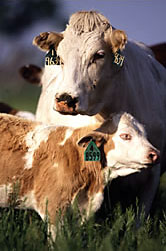Science Update
Less Irradiation Would Still Stop Fruit Pests
Irradiation may become more practical as a quarantine treatment to keep fruit flies from spreading via fresh produce shipments. Irradiation—safe, very low levels of gamma-ray energy—interrupts the insects' development so they can't reproduce. And new ARS studies with grapefruit and Mexican fruit flies indicate irradiation amounts could be cut by half or more. With a faster, cheaper irradiation treatment, produce could arrive at the supermarket sooner and retain more of its harvest quality. These findings make irradiation an even more feasible alternative to methyl bromide, a chemical scheduled for phaseout by 2001. In a pilot irradiation program begun 2 years ago, Hawaiian papayas and other tropical fruits are shipped to the Chicago area. There, exposure to 250 Grays (Gy) of gamma rays ensures that no hitchhiking oriental or Mediterranean fruit flies survive to adulthood. But 250 Gy—applied on a commercial scale—can damage oranges, mangoes, grapes, and other fruits. Recently, ARS scientists found that much lower doses stopped development of Mexican fruit flies. Their tests with grapefruit indicate 50 Gy may be adequate if these pests are hiding in fruit.
Guy J. Hallman and Donald B. Thomas, USDA-ARS Subtropical Agricultural Research Laboratory, Weslaco, Texas, phone (956) 447-6301.
Fat in Cow's Diet Helps Calves Keep Warm
About 95,000 calves die each year from cold stress. But extra fat in a cow’s diet for the last 6 weeks of pregnancy could help the newborn calf tolerate the cold. Preliminary test results have shown this for the first time. Researchers added safflower with a high concentration of linoleic fatty acid to the diets of 12 cows for 53 days before calving. Eleven other cows ate a standard feed ration. For the first 5 hours after birth, calves were kept at room temperature. Then they were put in a room at 32° F for 2 ½ hours. Calves whose mothers ate the extra fat maintained their body temperature better than did calves of cows fed the standard diet. The scientists believe the warmer calves had more brown fat, which surrounds organs such as kidneys and helps the animals generate body heat immediately after birth. Researchers are repeating the experiment and hope to determine the significance of fat-influenced body temperature differences.
USDA-ARS Fort Keogh Livestock and Range Research Laboratory, Miles City, Montana, phone 406-874-8200.
Computer Model Helps Grain Stay Too Cool for Bugs
Warm grain is prime breeding ground for rusty grain beetles, particularly in bins of more than 3,000 bushels. But cooling stored grain with automated fans can suppress the insects’ development and reproduction. This can reduce or eliminate the need for insecticide. ARS entomologists have developed a computer model, Stored Grain Advisor (SGA), to help growers and others determine when to use cooling fans as well as other tactics to suppress rusty grain beetles and lesser grain borer, two of the most common stored-grain insects. According to computer simulation studies, fans should be turned on when the air temperature is at least 18° F cooler than the grain temperature. This can hold insect numbers below damaging levels as far south as Oklahoma. It also saves energy and grain weight loss, because the fans turn on only when necessary. The SGA requires a computer with Microsoft Windows 3.1 or later. Farmers and grain elevator operators can get the software through the extension programs of Kansas, Oklahoma, and Montana State Universities. More details about SGA can be accessed on the World Wide Web at:
http://bru.gmprc.ksu.edu/proj/sga/
Paul W. Flinn, USDA-ARS U.S. Grain Marketing Research Laboratory, Manhattan, Kansas, phone (785) 776-2707.







